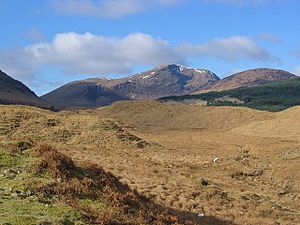Battle of Dalrigh facts for kids
Quick facts for kids Battle of Dalrigh |
|||||||
|---|---|---|---|---|---|---|---|
| Part of Wars of Scottish Independence | |||||||
 Dalrigh where the battle took place |
|||||||
|
|||||||
| Belligerents | |||||||
| Scottish Royal Army | Clan MacDougall Clan Macnaghten |
||||||
| Commanders and leaders | |||||||
| Robert the Bruce | John of Argyll | ||||||
| Strength | |||||||
| ca.500 | ca. 1,000 | ||||||
| Casualties and losses | |||||||
| Heavy | Light | ||||||
The Battle of Dalrigh was a fight in 1306 during the Wars of Scottish Independence. It happened between the army of King Robert the Bruce and the Clan MacDougall. The MacDougalls were allies of the Clan Comyn and the English.
The battle took place at a small village called Dalrigh in Perthshire, Scotland. Dalrigh means "King's Field" in Scottish Gaelic. King Robert's army was already weak after losing the Battle of Methven to the English. They were trying to escape west when the MacDougalls attacked them. Robert the Bruce's army was almost completely destroyed, and he barely got away. The exact date of the battle is not known, but it was in the summer of 1306.
Who were the MacDougalls?
The Clan MacDougall was a powerful family in Argyll, Scotland, by the late 1200s. They were descendants of Somerled, an important ruler of the Hebrides islands. The leader of the family, Alexander of Argyll, was related to King John Balliol and his nephew John Comyn.
When the War of Independence began in 1296, the MacDougalls supported King John Balliol. Later, in 1306, John Comyn was killed by Robert the Bruce and his group. Soon after, Robert Bruce was crowned King of Scots. The MacDougalls fought against King Robert. Because they supported the losing side, they eventually lost much of their power and lands.
The King's Field Battle
On June 19, 1306, King Robert the Bruce and his army were surprised at their camp near Perth. This was the Battle of Methven, where they were defeated by Aymer de Valence, an English general. What was left of Bruce's army headed west into the mountains of Argyll.
When they reached Strathfillan, their path was blocked at Tyndrum. A large force of MacDougalls, about 1,000 men, was waiting. They were led by John of Lorne, also known as John Bacach, meaning 'the Lame'. King Robert's small army had only 300 to 500 people, including some women and older people. They were forced to fight in a difficult situation.
The exact place of the battle is called Dail Righ in Gaelic, which means "the King's Field." We don't know if it was called this at the time or later.
Bruce's Escape
The only stories we have about the Battle of Dalrigh are from people who supported Robert the Bruce. These stories often make his actions seem very brave. The poet John Barbour wrote that Bruce "boldly waited" to fight John of Lorne, even though he had "too few" followers. However, Bruce's army had just been defeated. It's possible the MacDougalls surprised them.
During the battle, the MacDougall axemen attacked Bruce's remaining horses. Many of his men were hurt, including Sir James Douglas. Bruce tried his best to get his army away safely.
They thereupon withdrew. In this
There was no mark of cowardice.
They kept together; and the king
Was ever busy rescuing
The rearmost of his company.
With skill and valour there wrought he,
And safely all his men withdrew.
He daunted those that would pursue
So none durst leave their cloe array,
For he was never far away.
Bruce was so busy protecting the back of his army that he found himself alone at one point. He was attacked between a hill and a loch (lake). The path was so narrow he couldn't turn his horse. It is said that one attacker tore off the special brooch that held his cloak. This brooch became known as the "Brooch of Lorn." It was later owned by the MacDougall family.
The fact that the king was in such a dangerous spot, seemingly alone, shows how weak his army had become. The enemy was fought off, and the army retreated to safety. But soon after, it stopped being an organized fighting force.
Robert the Bruce's Flight
After the Battle of Dalrigh, Robert the Bruce was like a person on the run. His enemies, both Scottish and English, chased him closely. For a while, his group hid in the mountains of Atholl.
From there, King Robert sent his wife, Queen Elizabeth, his daughter Marjorie Bruce, his sister Mary, and Isabella MacDuff to Kildrummy Castle for safety. With James Douglas and a few others, he then escaped south. He was helped to cross to the Kintyre Peninsula by Aonghus Óg Mac Domhnaill, the chief of the MacDonalds. The MacDonalds were enemies of the MacDougalls.
Bruce found temporary safety in Dunaverty Castle. But this place was too open and dangerous to stay for long. From there, Angus MacDonald took the king to Rathlin Island, off the coast of Ulster. This was also MacDonald land. King Robert spent the winter there and returned in early spring of 1307. His recovery from this low point is one of the most amazing stories in military history.
Two years after Dalrigh, the MacDougalls were defeated at the Battle of Pass of Brander. After his great victory at Bannockburn, King Robert gave the MacDougall lands to the clans who had been loyal to him, including the MacDonalds.

